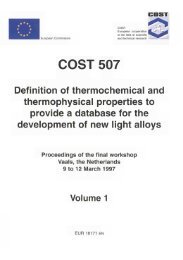Susana Isabel Ferreira da Silva de Sá ESTROGÉNIOS E ...
Susana Isabel Ferreira da Silva de Sá ESTROGÉNIOS E ...
Susana Isabel Ferreira da Silva de Sá ESTROGÉNIOS E ...
Create successful ePaper yourself
Turn your PDF publications into a flip-book with our unique Google optimized e-Paper software.
The studies incorporated in the present thesis contributed to clarify the role of sexual steroids<br />
in inducing the plastic changes displayed by neurons of the ventrolateral division of the<br />
hypothalamic ventromedial nucleus (VMNvl) across the ovarian cycle and to i<strong>de</strong>ntify the<br />
mechanisms by which estrogens exert this neurotrophic action. The studies were performed in<br />
young Wistar rats. The variations in the morphology and connectivity pattern of VMNvl<br />
neurons across the ovarian cycle were analyzed, at the ultrastructural level, in rats at diestrus 1<br />
and proestrus phases of the ovarian cycle. The quantification of the synaptic contacts<br />
established upon the VMNvl neurons of ovariectomized rats treated with estradiol or<br />
progesterone, alone or in association with RU486, allowed to characterize the effects of<br />
estrogen and progesterone in the induction of synaptic plasticity. In or<strong>de</strong>r to sort out the<br />
estrogen receptor isoform through which estrogens act to induce synaptogenesis,<br />
ovariectomized rats were treated with the specific agonists of the estrogen receptors α and β.<br />
To assess the role of neuronal afferents as mediators of the estrogen influence in the induction<br />
of new synapses and in the expression of progesterone receptors in the VMNvl, studies were<br />
done in ovariectomized rats that, after VMN <strong>de</strong>afferentation, were treated with estradiol.<br />
The results showed that there is a positive correlation between the circulating levels of<br />
sex steroid hormones and the size of the cytoplasmic organelles involved in protein synthesis<br />
and the number of nuclear pores and synapses established upon VMNvl neurons. In addition,<br />
they evinced that these effects are the leading cause of the variations in the magnitu<strong>de</strong> of the<br />
sexual dimorphisms displayed by several morphological features of the VMNvl along the<br />
ovarian cycle. Data obtained also <strong>de</strong>monstrated that progesterone does not promote the<br />
formation of new synapses in the VMNvl, and that the cyclic variations that occur in the<br />
number of VMNvl synapses over the estrous cycle is exclusively <strong>de</strong>pen<strong>de</strong>nt on estrogen<br />
actions. The finding that the synaptogenic effects of estradiol and of the specific agonists of<br />
the α and β subtypes of estrogen receptor were very similar allowed to draw the conclusion<br />
that these estrogen effects are mediated by the activation of its nuclear receptors. Moreover,<br />
the observation that VMN <strong>de</strong>afferentation prevented the estradiol-induced formation of new<br />
synapses showed that the synaptogenic effects of estrogens in the VMNvl are indirect and<br />
mediated by the neural afferents originating from regions of the brain that are estrogen-<br />
sensitive. Lastly, the finding that VMN <strong>de</strong>afferentation did not interfere with the induction of<br />
progesterone receptors by estradiol showed that to promote this effect, known to be critical<br />
for the induction of the female sexual behavior, estrogens act directly upon VMNvl neurons.<br />
97

















